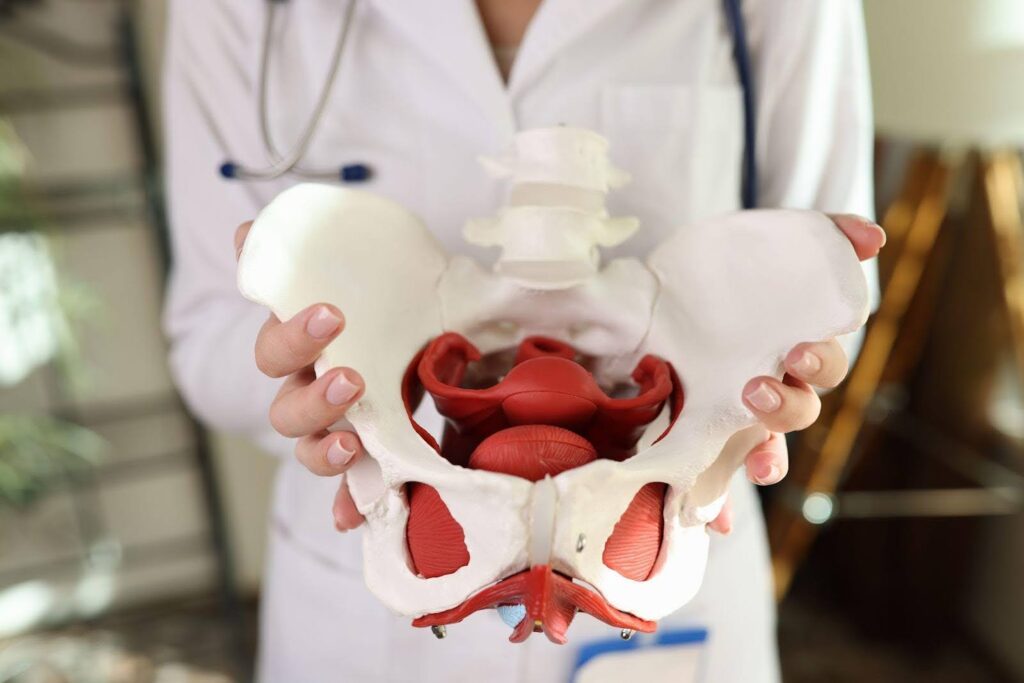Your pelvic floor health is the foundation of your core. This powerful group of muscles stretches like a supportive sling across the bottom of your pelvis. It stabilizes your spine and hips, controls bladder and bowel function, supports internal organs, and plays a vital role in sexual health.
Every time you lift, laugh, or take a deep breath, your pelvic floor works in harmony with your diaphragm, abdominals, and back muscles to keep you strong and balanced.
Pelvic floor health affects everyone — regardless of gender. While many associate pelvic floor exercises with postpartum recovery, these muscles influence daily function for men and women.
Weakness or imbalance in this area often leads to issues like incontinence, lower back pain, poor posture, or decreased core strength. Addressing these concerns starts with awareness and builds through proper training.
In this blog, you’ll discover how to strengthen your pelvic floor through expert-approved exercises and guided techniques. We’ll explore the signs of dysfunction, explain how pelvic floor therapy works, and outline practical steps to integrate these exercises into your daily life.
Whether you’re looking to recover after childbirth, enhance athletic performance, or simply improve core control, this guide provides the tools to move forward with strength and confidence.
Understanding the pelvic floor and when to seek support

Your pelvic floor forms the foundation of your core. This network of muscles, ligaments, and connective tissue stretches from the pubic bone to the tailbone and supports the bladder, rectum, and reproductive organs. These muscles activate during everyday movements — walking, lifting, breathing, laughing — providing stability and pressure control without conscious effort.
The pelvic floor works closely with your diaphragm, deep abdominal muscles (transversus abdominis), and spinal stabilizers (multifidus). This inner core unit regulates pressure within your torso and maintains posture. As you inhale, the diaphragm lowers and the pelvic floor expands; during exhalation, both lift and contract together.
Disruption in this system — whether from weakness, overuse, or tension — can throw off the entire balance and lead to dysfunction.
Pelvic floor issues arise for many reasons. Pregnancy, childbirth, prostate surgery, aging, chronic straining, poor posture, or high-impact exercise all strain these muscles. Over time, they lose strength or coordination, affecting how your body moves, functions, and feels.
Recognizing the signs of dysfunction helps you intervene early. Common symptoms include:
- Urinary or fecal incontinence: Leaking during exertion, sneezing, or laughter signals weakened pelvic control.
- Pelvic pressure or heaviness: A bulging sensation may indicate organ prolapse and reduced muscular support.
- Pain during intercourse or exams: Tightness or imbalance in the pelvic floor often causes discomfort and tension.
- Lower back pain and poor posture: Weak pelvic muscles force surrounding structures to compensate, leading to instability.
- Diastasis recti and core weakness: Separation of abdominal muscles commonly coincides with pelvic dysfunction, reducing core strength and increasing injury risk.
Why strengthening the pelvic floor matters
Improves bladder and bowel control
A strong pelvic floor plays a key role in managing pressure from your bladder and bowels. When these muscles activate properly, they hold in urine and stool until you decide to release them. Weakness in this area leads to accidental leaks, urgency, or incomplete elimination. Strengthening the pelvic floor restores control and reduces the chances of incontinence.
Supports sexual function and comfort
Pelvic floor muscles contribute to sensation, arousal, and muscle coordination during intercourse. Weakness or tension can cause discomfort or reduce satisfaction. Individuals often report improved sensitivity, greater control, and enhanced intimacy by strengthening these muscles.
In both men and women, better muscle function supports sexual confidence and comfort.
Enhances core strength and posture
The pelvic floor acts as the foundation of your core. It works together with the deep abdominals, diaphragm, and spinal muscles to stabilize your body during movement. When the pelvic floor weakens, other muscles compensate, leading to poor alignment and back pain. Strengthening this area restores balance, improves body mechanics, and supports upright posture.
Prevents or reduces pelvic organ prolapse
Pelvic organ prolapse occurs when weakened muscles allow internal organs like the bladder, uterus, or rectum to drop into the vaginal or rectal area. This condition often results in pressure, bulging, or discomfort.
A well-functioning pelvic floor offers essential support to keep these organs in place, reducing the risk of prolapse or minimizing its progression.
Aids in postpartum and post-surgical recovery
Pregnancy, childbirth, and abdominal or pelvic surgeries place enormous strain on the pelvic floor. Recovery involves restoring muscle tone, coordination, and endurance. Targeted exercises help mothers and patients rebuild strength, ease discomfort, and return to daily life with greater confidence. Early intervention also helps prevent long-term dysfunction.
Strengthening the pelvic floor delivers benefits that extend far beyond the pelvis. It supports your body’s function, stability, and quality of life — at every stage.
How a pelvic floor specialist helps

What is pelvic floor physical therapy?
Pelvic floor physical therapy focuses on restoring strength, function, and coordination to the muscles that support your bladder, bowels, and reproductive organs. A licensed pelvic health specialist works with you to evaluate how well your pelvic muscles engage and release.
This form of therapy goes beyond generic core exercises. It targets deep muscular layers that influence posture, stability, and internal organ support.
What to expect during an evaluation
Your first visit typically begins with a detailed conversation about your symptoms, medical history, and physical goals. The specialist then performs a personalized physical assessment, which may include posture analysis, breathwork observation, and internal and external evaluations of your pelvic floor muscles.
This thorough approach helps identify muscle weakness, tension, imbalances, or coordination issues that affect your daily function.
Tools and techniques for recovery
Treatment often combines multiple strategies tailored to your needs.
- Biofeedback uses sensors to provide real-time data about your pelvic muscle activity, helping you learn to engage and release the muscles more effectively.
- Manual therapy includes gentle, hands-on techniques to release tension, improve circulation, and restore normal movement in pelvic tissues.
- Education plays a central role. Your provider will teach you how to adjust body mechanics, breathing patterns, and posture to reduce strain and prevent setbacks.
Personalized exercise plans
No two bodies respond the same way, which is why pelvic floor therapy relies on custom plans. Your specialist selects exercises that match your strength level, flexibility, and specific goals.
Whether you’re working to eliminate leakage, improve intimacy, or recover from childbirth or surgery, your program evolves with your progress. You’ll learn how to integrate these movements into everyday life for lasting results.
Working with a pelvic floor specialist gives you expert support and a clear roadmap for recovery. You build a stronger, more resilient foundation for your body through personalized care, education, and hands-on guidance.
Foundational pelvic floor exercises
Strengthening your pelvic floor requires more than isolated movements. These exercises build a deep connection between your breath, core, and pelvic floor muscles. Practicing with intention helps you retrain movement patterns, relieve tension, and improve muscular control over time.
Kegels: master the contraction
Kegels target the pelvic floor muscles by teaching you how to contract and lift them. To begin, imagine you are stopping the flow of urine or holding in gas — this mimics the correct muscles.
Gently contract and lift without tightening your glutes, thighs, or abdomen. Hold for 3–5 seconds, then release completely. Repeat 10–15 times, focusing on control, not force. Avoid overuse; quality matters more than quantity.
Reverse Kegels: relax and release
Pelvic floor health depends on both strength and flexibility. Reverse Kegels train your body to release tension in the pelvic muscles. Breathe deeply into your belly and feel your pelvic floor expand.
Imagine gently pushing the muscles downward, like a soft sigh through your lower abdomen. This helps counter tightness, which often contributes to discomfort, pain, or dysfunction.
Diaphragmatic breathing with coordination
Your breath connects directly with your pelvic floor. As you inhale, your diaphragm expands, and your pelvic floor should gently release. As you exhale, your pelvic floor lifts and engages. Practice lying on your back with one hand on your belly. Breathe deeply, allowing your belly and pelvic floor to rise and fall together.
Over time, this coordination builds foundational stability and improves core control.
Glute bridges with pelvic floor engagement
Lie on your back with knees bent and feet flat. Inhale to prepare. As you exhale, gently contract your pelvic floor and lift your hips toward the ceiling. Keep your spine neutral and avoid clenching your glutes. Hold for a few seconds, then lower slowly. This move combines hip strength, core support, and pelvic stability in one functional motion.
Transverse abdominis activation
The transverse abdominis (TVA) acts as a corset for your core. Strengthening this deep muscle layer supports pelvic alignment and posture. To engage it, lie down with knees bent. Inhale to expand your ribs, then exhale slowly as you draw your navel gently toward your spine without moving your pelvis.
Pair this with a pelvic floor contraction for added support. Over time, this move improves coordination and protects against strain.
Integrating pelvic floor training into your daily routine
Strengthening your pelvic floor doesn’t require long workouts or rigid schedules. In fact, you make the most progress by weaving awareness and activation into your everyday movements. The key lies in consistency, proper form, and knowing when to rest or seek guidance.
Build consistency with short, focused sessions
Consistency matters more than intensity. Start with a few minutes each day and link your exercises to daily habits. For example, perform pelvic floor contractions during teeth brushing, while waiting for coffee, or before bed. Set reminders on your phone or use habit-tracking apps to stay on track.
As your coordination improves, gradually increase repetitions and hold times to challenge your muscles safely.
Practice awareness during daily movements
Your pelvic floor is involved in nearly every movement. Train your body to engage it during physical tasks like lifting, walking, or even standing for long periods. Before picking up a child or a heavy bag, gently contract your pelvic floor and core.
When walking, stay mindful of your posture and stride, allowing your pelvic muscles to support your spine and pelvis naturally. This functional approach helps reinforce strength throughout the day, not just during workouts.
Avoid common mistakes
Overtraining may lead to tension or fatigue. Avoid performing Kegels all day or clenching your muscles without breaks. Proper form also matters — many people unknowingly contract their glutes, thighs, or abs instead of the pelvic floor.
Take time to isolate the right muscles and include relaxation techniques like reverse Kegels and breathwork. Remember: balanced strength comes from both contraction and release.
Adjust intensity and seek expert input when needed
As you progress, your needs may shift. You might reach a plateau or notice new symptoms. This is the time to re-evaluate your technique, adjust intensity, or work with a pelvic floor specialist. They assess your movement patterns, correct form, and personalize your routine to match your goals.
Stop and consult a professional if you experience pain, increased leakage, or pressure during exercises.

Strengthen your foundation with iVee Restorative Care
At iVee Restorative Care, we believe your body deserves expert guidance, not guesswork. Our pelvic floor specialists take time to understand your goals, evaluate your needs, and create a personalized plan that builds strength, restores function, and supports long-term wellness.
Whether you’re recovering from childbirth, managing chronic symptoms, or looking to enhance your performance, we meet you where you are and help you move forward with strength and confidence.
If you’re ready to improve your core from the inside out, contact iVee Restorative Care today.


